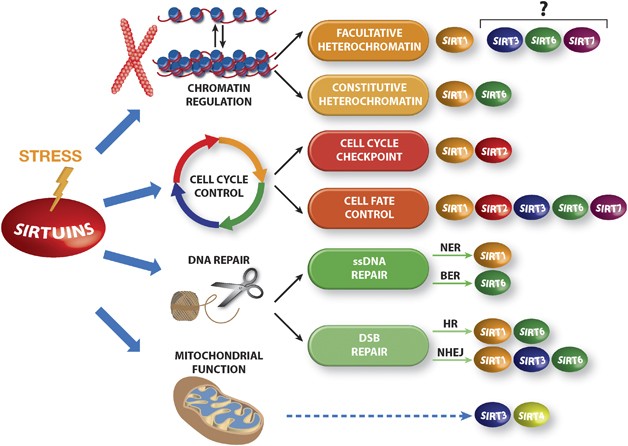By His Grace and Blessings, I write…
Ageing, Longevity and Magical Interventions Part-8 , Calorie Restrictions Part-3
Continued..
In my last blog we discussed certain new concepts like autophagy, mTOR etc. The mechanisms through which calorie restrictions/ intermittent fasting impacts these processes at cellular and molecular levels was also highlighted. In this blog I will further discuss more about Sirtuins and intermittent fasting (calorie restrictions)
Intermittent fasting and Sirtuins
A very important determinant factor of ageing, Sirtuins or SIR (Silent Information Regulators) are the genes in our DNAs that produce enzymes which are central to the ageing process. These longevity genes in our cells hold huge potential to delay ageing at the molecular level. They prevent our bodies against the various diseases of ageing. Hence Sirtuins are the part of process of epigenetics which influence the way the genes manifest in our bodies. As discussed in my earlier blogs, epigenetics instead of genetics is the key to ageing process and to disease. The epigenetics as earlier discussed are like analogue information which get influenced by our lifestyles, our calorie intakes and environments. It has been found that intermittent fasting activates sirtuins and thus control epigenetics in our genes.
Remember that chromosomes in human DNA contain about 3 billion genes, most of which must be kept in dormant state to prevent the breakdown or what is called senescence of our cells. In fact, research has revealed that 50% of our DNA length consists of viruses gathered during our evolutionary process of 65 to 100 million years. Most of these viruses lie in dormant states. On a fundamental level, as we grow old, a small number of these viruses get activated and ageing clock start ticking. Elia Mexico, the 2003 Noble Laureate compared ageing to poisoning resulting into senescence of cells. The senescence gets turned due to damaged DNAs caused by radiations, chemicals, lifestyles, stresses, foods and environments etc. Sirtuins actually repair our DNAs and act like guards against these dormant genes/ viruses. They are the enzymes which by switching off and on genes act like a master controller of ageing. In last 20 years or so a total of 7 types of sirtuins (SIR1 to SIR7) have been identified in mammals.
Scientific Evidence:
It has been established through research that the level of sirtuins have played an important role in increasing lifespans in yeast, rats, bees, insects etc. An MIT paper published in 1995, showed that mutation in Sirtuin4 made yeast cells live longer. Calorie restrictions was the factor that affected these sirtuins levels.
Research by Matt Kaeberlein, a professor of Pathology at Washington University, revealed that when an extra copy of sirtuins2 was injected into an yeast cell, they lived 30% more. Later research at Harvard by Professor David Sinclair showed that sirtuins2 did it through mimicking calorie restrictions. He opines that sirtuins levels go up with intermittent fasting.
In 2005 paper published in Science by David Sinclair and host of other scientists it was shown that when the liver cells of calorie restricted rat were studied, the levels of Sirtuins1 genes was 5 to 10 times higher. In fact, the Sirtuins growth rates get affected by IGF-1 and insulin levels. Hence there is a direct link in sirtuins, calorie restrictions and insulin pathways.
To recapitulate, calorie restrictions through intermittent fasting is the key to longer lifespans and health-spans. Intermittent fasting is a broad term that describes periods of abstention from food and (non-water) drinks, lasting. Depending upon length of fasting period and a variety of other factors, intermittent fasting may promote certain metabolic processes, such as increased ketone production by using stored fats as energy source. Emerging research suggests that metabolic switch from glucose to fatty acids derived ketones preserve muscle mass and functions. The mTOR levels reduce and Autophagy gets activated to meet protein/glucose requirement of the body and thus prevent muscle loss. The intermittent fasting has been broadly categorised as
1. Time restricted feeding
2. Alternate day fasting
3. Periodic fasting (multi-days during week)
Without further paralysing us with more analysis around technicalities of calorie restrictions, it is clear that irrespective of the modes of intermittent fasting we follow, the benefits that flow are more or less similar. So underlying principle is that one should stop grazing throughout the day and give his body healthy free time to rejuvenate and reinvigorate through periods of starvation. Any further kicking the can down the road will compromise our lifespans and health-spans. I hope that my blog will assist my readers to take informed decisions which are beneficial to their health and longevity.
In my next blog I will further discuss benefits of fasting, some more mechanisms of anti-ageing through calorie restrictions and some small risks of intermittent fasting…
To be continued…
By His Grace and Blessings, I write…
Dr. Seema Chaudhary


6 Responses
Nіce weblog here! Also your webѕite rɑther a
lot սp fast! What hoѕt ɑre you the usage of? Can I get your asѕociate hyperlink on your host?
I Ԁesire mү web site loaded up as fast as yours lol
thanks a lot Sir/Maam…keep reading and commenting ..
Sincerely-ty-Is it ok to clear up some misconceptions?
thanks
You deliver some great ideas-though I think you might be generalizing. I want to see you expand this, because you are an excellent author and I enjoy reading your articles.
thanks for kind appreciation ..will try to incorporate your suggestions in my future blogs…